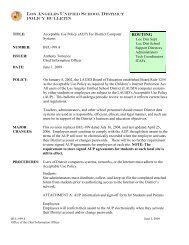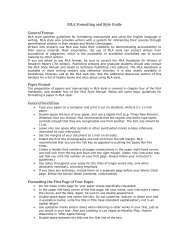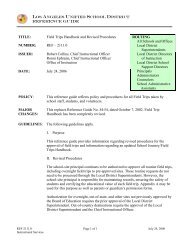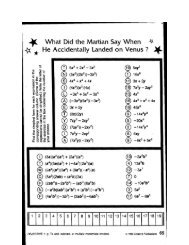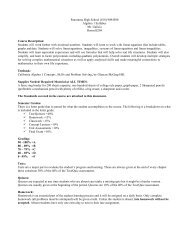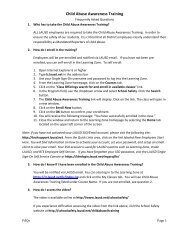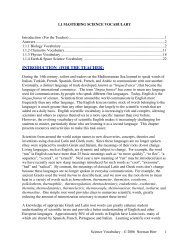ExamView - FINAL EXAM REVIEW 2011.tst
ExamView - FINAL EXAM REVIEW 2011.tst
ExamView - FINAL EXAM REVIEW 2011.tst
You also want an ePaper? Increase the reach of your titles
YUMPU automatically turns print PDFs into web optimized ePapers that Google loves.
<strong>FINAL</strong> <strong>EXAM</strong> <strong>REVIEW</strong> 2011<br />
Multiple Choice<br />
Evaluate the expression for the given value of the variable(s).<br />
____ 1.<br />
4(3h − 6)<br />
;h = −2<br />
1 +h<br />
a. 32 b. 48 c. −48 d. 30<br />
____ 2. −x 2 − 4x − 4; x = –3<br />
a. 3 b. –1 c. 11 d. –17<br />
____<br />
3. The expression −16t 2 + 1800 models the height of an object t seconds after it has been dropped from a height<br />
of 1800 feet. Find the height of an object after falling for 4.8 seconds.<br />
a. 2168.64 ft b. 1431.36 ft c. 1723.2 ft d. 7698.24 ft<br />
Simplify by combining like terms.<br />
____<br />
4. 4c − 4d + 8c − 3d<br />
a. 12c + 7d b. 12c − 7d c. −12c − 7d d. −7c + 12d<br />
____ 5. If a = b, then a – c ____ equals b – c.<br />
a. always b. sometimes c. never<br />
Solve the equation.<br />
____ 6. 6(x − 0.8) − 0.2( 5x − 4) = 6<br />
a. –0.5 b. –2 c. 0.5 d. 2<br />
____ 7. 9x 2 + 16 = 0<br />
a. − 4 3 i, 4 3 i c. −3 4 i, 3 4 i<br />
b. − 16 16<br />
i,<br />
9 9 i d. −4 3 , 4 3<br />
____ 8. x 2 + 18x + 81 = 25<br />
a. 14, 4 c. 14, –14<br />
b. –4, –14 d. –4, 4<br />
____ 9. x + 10 − 7 = −5<br />
a. 14 b. –8 c. 4 d. –6<br />
1
<strong>FINAL</strong> <strong>EXAM</strong> <strong>REVIEW</strong> 2011<br />
Solve for x. State any restrictions on the variables.<br />
____ 10. ax + bx +9 =7<br />
2<br />
a. x =<br />
a + b ; a≠b c. x = 7<br />
a + b +9 ; a + b ≠ −9<br />
7<br />
b. x =<br />
a + b +9 ; a ≠ 0, b ≠ −9 d. x = −2<br />
a + b ; a ≠ −b<br />
Solve the inequality. Graph the solution set.<br />
____ 11. 2 + 2k ≤ 8<br />
a. k ≥ 3 c. k ≤ 3<br />
b. k ≤ 5 d. k ≥ 5<br />
____ 12. 26 + 6b ≥ 2(3b + 4)<br />
a. all real numbers c. b ≥ 1 1 2<br />
b. b ≤ 1 1 2<br />
d. no solutions<br />
Solve the problem by writing an inequality.<br />
____ 13. A club decides to sell T-shirts for $12 as a fund-raiser. It costs $20 plus $8 per T-shirt to make the T-shirts.<br />
Write and solve an equation to find how many T-shirts the club needs to make and sell in order to profit at<br />
least $100.<br />
a. 12x − ( 8x + 20) ≥ 100; x ≥ 30 c. (8x + 20) − 12x ≥ 100; x ≥ 20<br />
b. 12x − 8x + 20 ≥ 100; x ≥ 20 d. 12x − 8(x + 20) ≥ 100; x ≥ 20<br />
2
<strong>FINAL</strong> <strong>EXAM</strong> <strong>REVIEW</strong> 2011<br />
Solve the compound inequality. Graph the solution set.<br />
____ 14. −2 ≤ 2x − 4 < 4<br />
a. 0 ≤ x < − 2 c. 1 ≤ x < 0<br />
b. 1 ≤ x < 4 d. 3 ≤ x < 6<br />
____ 15. The perimeter of a square garden is to be at least 22 feet but not more than 36 feet. Find all possible values<br />
for the length of its sides.<br />
a. 11 41 4<br />
3
<strong>FINAL</strong> <strong>EXAM</strong> <strong>REVIEW</strong> 2011<br />
____ 20. Suppose f ( x) = 4x − 2 and g( x) = −2x + 1.<br />
f( 5)<br />
Find the value of<br />
g( −3) .<br />
a. 1 5 9<br />
b. 2 4 7<br />
c. −2 d. 2<br />
Find the slope of the line through the pair of points.<br />
____ 21. (− 1 3 , 0) and (−1 2 , −1 2 )<br />
a. −3 b.<br />
1<br />
3<br />
c. − 1 3<br />
d. 3<br />
____ 22. Find the point-slope form of the equation of the line passing through the points (–6, –4) and (2, –5).<br />
a. y + 4 = 1 8 (x – 2) c. y + 5 = −1 (x + 6)<br />
8<br />
b. y + 4 = − 1 8 (x + 6) d. y + 4 = 1 (x + 6)<br />
8<br />
Find the slope of the line.<br />
____ 23. y = − 1 2 x − 4<br />
a. − 1 2<br />
b.<br />
1<br />
2<br />
c. –4 d. none of these<br />
____ 24. x = a<br />
a. a b. 0 c. undefined d. 1<br />
____ 25. A 3-mi cab ride costs $3.00. A 6-mi cab ride costs $4.80. Find a linear equation that models cost c as a<br />
function of distance d.<br />
a. c = 0.80d + 1.20 c. d = 0.60c + 1.80<br />
b. c = 1.00d + 1.80 d. c = 0.60d + 1.20<br />
4
<strong>FINAL</strong> <strong>EXAM</strong> <strong>REVIEW</strong> 2011<br />
Graph the inequality.<br />
____ 26. 4x – 2y < –3<br />
a. c.<br />
b. d.<br />
5
<strong>FINAL</strong> <strong>EXAM</strong> <strong>REVIEW</strong> 2011<br />
Graph the absolute value inequality.<br />
____ 27. y < |x + 2| – 2<br />
a. c.<br />
b. d.<br />
6
<strong>FINAL</strong> <strong>EXAM</strong> <strong>REVIEW</strong> 2011<br />
____ 28. y ≥ |x + 3| – 2<br />
a. c.<br />
b. d.<br />
____ 29. A group of 52 people attended a ball game. There were three times as many children as adults in the group.<br />
Set up a system of equations that represents the numbers of adults and children who attended the game and<br />
solve the system to find the number of children who were in the group.<br />
Ï<br />
Ï<br />
a + c = 52<br />
a.<br />
Ô<br />
Ì ; 39 adults; 25 children c.<br />
Ôa + c = 52<br />
Ì ; 25 adults; 39 children<br />
ÓÔ<br />
a = c + 3<br />
ÓÔ<br />
c = a + 3<br />
Ï<br />
Ï<br />
a + c = 52<br />
b.<br />
Ô<br />
Ì ; 39 adults, 13 children d.<br />
Ôa + c = 52<br />
Ì ; 13 adults, 39 children<br />
ÓÔ<br />
a = 3c<br />
ÓÔ<br />
c = 3a<br />
Solve the system.<br />
____ 30.<br />
Ï<br />
Ô−4x + 4y = −8<br />
Ì<br />
ÓÔ<br />
x − 4y = −7<br />
a. (3, 5) b. (5, 3) c. (–3, –5) d. (–5, –3)<br />
7
<strong>FINAL</strong> <strong>EXAM</strong> <strong>REVIEW</strong> 2011<br />
____ 31.<br />
____ 32.<br />
____ 33.<br />
Ï<br />
Ô0.18f − 0.3g = 3<br />
Ì<br />
ÓÔ<br />
0.15g − 0.9f = −5.55<br />
a. f = –7, g = 5 c. f = 5, g = 7<br />
b. f = –5, g = –7 d. f = 5, g = –7<br />
Ï<br />
Ô−x + 2y = 10<br />
Ì<br />
ÓÔ<br />
−3x + 6y = 11<br />
a. infinite solutions c. (5, –2)<br />
b. (–5, 2) d. no solutions<br />
Ï<br />
2x − 2y + z = −15<br />
Ô<br />
Ì6x − 3y − z = −19<br />
ÓÔ<br />
3x − y − z = −6<br />
a. (1, 8, 0) b. (–3, 2, –5) c. (1, 11, 5) d. (–1, 3, 4)<br />
8
<strong>FINAL</strong> <strong>EXAM</strong> <strong>REVIEW</strong> 2011<br />
Solve the system of inequalities by graphing.<br />
____ 34.<br />
Ï<br />
Ôx ≥ −2<br />
Ì<br />
ÓÔ<br />
y > 3<br />
a. c.<br />
b. d.<br />
____ 35. Equivalent systems of two linear equations ____ have the same solutions.<br />
a. always b. sometimes c. never<br />
Factor the expression.<br />
____ 36. 8x 2 + 12x − 16<br />
a. −2(−4x 2 + 12x − 16) c. 8x(−2x − 3)<br />
b. 8x 2 + 12x − 16 d. −4(−2x 2 − 3x + 4)<br />
____ 37. x 2 + 14x + 48<br />
a. (x + 6)(x − 8) c. (x − 8)(x − 6)<br />
b. (x + 8)(x − 6) d. (x + 6)(x + 8)<br />
9
<strong>FINAL</strong> <strong>EXAM</strong> <strong>REVIEW</strong> 2011<br />
____ 38. x 2 −6x +8<br />
a. (x + 4)(x + 2) c. (x − 4)(x + 2)<br />
b. (x − 2)(x − 4) d. (x − 2)(x + 4)<br />
____ 39. 3x 2 + 26x + 35<br />
a. (x + 5)(3x + 7) c. (3x + 5)(x − 7)<br />
b. (3x + 7)(x − 5) d. (3x + 5)(x + 7)<br />
____ 40. 9x 2 − 16<br />
a. (3x + 4)(−3x − 4) c. (−3x + 4)(3x − 4)<br />
b. (3x + 4)(3x − 4) d. (3x − 4) 2<br />
____ 41. x 3 + 216<br />
a. (x − 6)(x 2 + 6x + 36) c. (x − 6)(x 2 − 6x + 36)<br />
b. (x + 6)(x 2 − 6x + 36) d. (x + 6)(x 2 + 6x + 72)<br />
____ 42. c 3 − 512<br />
a. −(c − 8)(c 2 + 8c + 64) c. (c + 8)(c 2 + 8c + 64)<br />
b. (c − 8)(c 2 + 8c + 64) d. (c − 8)(c 2 − 8c − 64)<br />
10
<strong>FINAL</strong> <strong>EXAM</strong> <strong>REVIEW</strong> 2011<br />
____ 43. Identify the graph of the complex number −3 − 2i.<br />
a. c.<br />
b. d.<br />
Simplify the expression.<br />
____ 44. (−6i)(−6i)<br />
a. 36 b. –36 c. –36i d. 36i<br />
____ 45. Find the missing value to complete the square.<br />
x 2 + 2x + ____<br />
a. 2 b. 1 c. 4 d. 8<br />
Solve the quadratic equation by completing the square.<br />
____ 46. x 2 + 10x + 14 = 0<br />
a. −10 ± 6 c. 5 ± 6<br />
b. 100 ± 11 d. −5 ± 11<br />
11
<strong>FINAL</strong> <strong>EXAM</strong> <strong>REVIEW</strong> 2011<br />
Rewrite the equation in vertex form.<br />
____ 47. y = x 2 + 10x + 16<br />
a. y = (x + 5) 2 + 41 c. y = (x + 10) 2 + 11<br />
b. y = (x + 10) 2 − 9 d. y = (x + 5) 2 − 9<br />
Use the Quadratic Formula to solve the equation.<br />
____ 48. 4x 2 − x + 3 = 0<br />
a.<br />
1<br />
8 ± 47<br />
8<br />
b. 8 ± i 94<br />
8<br />
c.<br />
d.<br />
1<br />
8 ± i 47<br />
8<br />
1<br />
4 ± i 47<br />
4<br />
____ 49. Write 4x 2 (–2x 2 + 5x 3 ) in standard form. Then classify it by degree and number of terms.<br />
a. 2x + 9x 4 ; quintic binomial c. 2x 5 – 8x 4 ; quintic trinomial<br />
b. 20x 5 – 8x 4 ; quintic binomial d. 20x 5 – 10x 4 ; quartic binomial<br />
____ 50. Use a graphing calculator to determine which type of model best fits the values in the table.<br />
x –6 –2 0 2 6<br />
y –6 –2 0 2 6<br />
a. quadratic model c. linear model<br />
b. cubic model d. none of these<br />
____ 51. Determine which binomial is a factor of −2x 3 + 14x 2 − 24x + 20.<br />
a. x + 5 b. x + 20 c. x – 24 d. x – 5<br />
____ 52. Solve x 4 − 34x 2 = −225.<br />
a. no solution c. 3, –3, 5, –5<br />
b. 3, –5 d. 3, –3<br />
____ 53. Find a quadratic equation with roots –1 + 4i and –1 – 4i.<br />
a. x 2 − 2x + 17 = 0 c. x 2 + 2x + 17 = 0<br />
b. x 2 + 2x − 17 = 0 d. x 2 − 2x − 17 = 0<br />
____ 54. Use the Binomial Theorem to expand (d − 3b) 3 .<br />
a. d 3 − 3d 2 b + 3db 2 − b 3<br />
b. d 3 + 3d 2 b + 3db 2 + b 3<br />
c. d 3 + 9d 2 b + 27db 2 + 27b 3<br />
d. d 3 − 9d 2 b + 27db 2 − 27b 3<br />
____ 55. Determine the probability of getting four heads when tossing a coin four times.<br />
a. 0.5 b. 0.375 c. 0.25 d. 0.0625<br />
12
<strong>FINAL</strong> <strong>EXAM</strong> <strong>REVIEW</strong> 2011<br />
Multiply and simplify if possible.<br />
4<br />
____ 56. 3<br />
⋅<br />
4<br />
−3<br />
4<br />
a. –3 b. 3 c. 3 −3<br />
Ê<br />
ˆ<br />
____ 57. 7x x −7 7<br />
Ë<br />
Á<br />
¯<br />
˜<br />
a. x 7 − 49 x c. x 7 − x 49<br />
b. 7x − 49x d. − 42x<br />
d. not possible<br />
Rationalize the denominator of the expression. Assume that all variables are positive.<br />
____ 58.<br />
a.<br />
b.<br />
6x 8 y 9<br />
5x 2 y 4<br />
x 3 y 2 30y<br />
5<br />
c. 5x 3 y 2 30y<br />
30x 10 y 13<br />
d. none of these<br />
5x 2 y 4<br />
____ 59.<br />
3<br />
2 + 3<br />
3<br />
6<br />
a.<br />
b.<br />
3<br />
2 6<br />
3<br />
2 36<br />
3<br />
+ 9 18<br />
6<br />
3<br />
+ 3 2<br />
6<br />
c.<br />
d.<br />
3<br />
2 6<br />
3<br />
2 36<br />
3<br />
+ 9 4<br />
6<br />
3<br />
+ 3 4<br />
6<br />
Simplify.<br />
____ 60. − 5 − 3 36 + 6 5<br />
1<br />
____ 61. 20 2<br />
⋅ 20<br />
a. 5 5 − 18 c. −5 5 − 18<br />
b. 5 5 − 3 36 d. none of these<br />
1<br />
2<br />
1<br />
a.<br />
4<br />
20<br />
b. 20 c. 20 d. 1<br />
1<br />
____ 62. 3 3<br />
⋅ 9<br />
1<br />
3<br />
3<br />
a. 9 b. 3<br />
c. 3 d. 3<br />
13
<strong>FINAL</strong> <strong>EXAM</strong> <strong>REVIEW</strong> 2011<br />
Multiply.<br />
____ 63.<br />
2<br />
Ê ˆ<br />
−5 − 3<br />
Ë<br />
Á<br />
¯<br />
˜<br />
a. 28 + 10 3 c. −13 + 5 3<br />
b. 28 − 10 3 d. 25 − 10 3<br />
____ 64.<br />
Ê ˆ<br />
8 − 2<br />
Ë<br />
Á<br />
¯<br />
Ê<br />
Ë<br />
Á 9 + 5 ˆ<br />
¯<br />
˜<br />
a. 72 − 10 c. 72 − 2 10<br />
b. 72 + 8 5 − 9 2 − 10 d. 72 − 3 − 10<br />
____ 65. ( −2x + 6)<br />
5 = ( −8 + 10x)<br />
7<br />
a.<br />
b.<br />
6<br />
1<br />
1<br />
5<br />
2<br />
3<br />
c. − 1 4<br />
d.<br />
6<br />
7<br />
____ 66. Let f(x) = 3x + 2 and g(x) = x − 3. Find f(x) – g(x).<br />
a. 2x – 5 b. 2x + 5 c. 4x – 1 d. 2x – 1<br />
____ 67. Let f(x) = −2x − 7 and g(x) = −4x + 3. Find (f û g)(−5).<br />
a. 23 b. –53 c. –9 d. 3<br />
____ 68. How much money invested at 5% compounded continuously for 3 years will yield $820?<br />
a. $952.70 b. $818.84 c. $780.01 d. $705.78<br />
Write the equation in logarithmic form.<br />
____ 69. 6 4 = 1, 296<br />
a. log 6<br />
1, 296=4 c. log 1, 296 = 4 ⋅ 6<br />
b. log 1, 296=4 d. log 4<br />
1, 296=6<br />
____ 70. Write the equation log 32<br />
8= 3 in exponential form.<br />
5<br />
3<br />
3<br />
a.<br />
5<br />
32 = 8 b.<br />
5<br />
8 = 32 c.<br />
Ê 3 ˆ<br />
Ë<br />
Á 5 ¯<br />
˜<br />
32<br />
5<br />
= 8 d.<br />
3<br />
8 = 32<br />
State the property or properties of logarithms used to rewrite the expression.<br />
____ 71. log 5<br />
6 − log 5<br />
2 = log 5<br />
3<br />
a. Quotient Property c. Difference Property<br />
b. Product Property d. Power Property<br />
____ 72. log 4<br />
7 + log 4<br />
2 = log 4<br />
14<br />
a. Quotient Property c. Addition Property<br />
b. Power Property d. Product Property<br />
14
<strong>FINAL</strong> <strong>EXAM</strong> <strong>REVIEW</strong> 2011<br />
Write the expression as a single logarithm.<br />
____ 73. 4 log x − 6 log (x + 2)<br />
a.<br />
x<br />
24 log<br />
x + 2<br />
c. log x(x + 2) 24<br />
b. log x 4 (x + 2) 6 d. none of these<br />
Expand the logarithmic expression.<br />
n<br />
____ 74. log 7<br />
2<br />
a. log 7<br />
n − log 7<br />
2 c. log 7<br />
2 − log 7<br />
n<br />
b.<br />
log 7<br />
n<br />
log 7<br />
2<br />
d. −n log 7<br />
2<br />
____ 75. log 3<br />
11p 3<br />
a. log 3<br />
11 ⋅ 3 log 3<br />
p c. log 3<br />
11 + 3 log 3<br />
p<br />
b. log 3<br />
11 − 3 log 3<br />
p d. 11 log 3<br />
p 3<br />
57<br />
____ 76. log b<br />
74<br />
1<br />
a.<br />
2 log 57 + 1 b<br />
2 log 74 c. log 57 − log 74<br />
b b b<br />
1<br />
b.<br />
2 log 57 − 1 b<br />
2 log 74 d. log 1<br />
b b<br />
(57 − 74)<br />
2<br />
____ 77. A construction explosion has an intensity I of 4.85×10 −2 W/m 2 . Find the loudness of the sound in decibels if<br />
L=10 log I<br />
I 0<br />
and I o<br />
= 10 −12 W/m 2 . Round to the nearest tenth.<br />
a. 146.9 decibels c. 106.9 decibels<br />
b. 115.8 decibels d. 48.5 decibels<br />
____ 78. Solve log(4x + 10) = 3.<br />
a. − 7 4<br />
b.<br />
495<br />
2<br />
c. 250 d. 990<br />
____ 79. Solve 3 log 2x= 4. Round to the nearest ten-thousandth.<br />
a. 10.7722 b. 5 c. 2.7826 d. 0.6309<br />
____ 80. Solve log 3x + log 9 = 0. Round to the nearest hundredth if necessary.<br />
a. 0.33 b. 0.04 c. 3 d. 27<br />
____ 81. Solve 2 log 4 − log 3 + 2 log x − 4 = 0. Round to the nearest ten-thousandth.<br />
a. 12.3308 b. 43.3013 c. 86.6025 d. 1875<br />
15
<strong>FINAL</strong> <strong>EXAM</strong> <strong>REVIEW</strong> 2011<br />
____ 82.<br />
p 2 − 4p − 32<br />
p + 4<br />
a. −p + 8; p ≠ −4 c. −p − 8; p ≠ 4<br />
b. p − 8; p ≠ −4 d. p + 8; p ≠ 4<br />
Multiply or divide. State any restrictions on the variables.<br />
____ 83.<br />
____ 84.<br />
4a 5<br />
7b 4 ⋅ 2b 2<br />
2a 4<br />
a.<br />
b.<br />
4a 9<br />
7b , a≠0, b≠0 c. 7b 2<br />
6 4a<br />
, a≠0, b≠0<br />
4a<br />
7b , a≠0, b≠0 d. 4<br />
2 7 a9 b 6 , a≠0, b≠0<br />
x 2 − 16<br />
x 2 + 5x + 6 ÷ x 2 + 5x + 4<br />
x 2 − 2x − 8<br />
a.<br />
b.<br />
c.<br />
d.<br />
(x − 4) 2<br />
(x + 3)(x + 1) ; x ≠ − 3, − 1<br />
(x + 4) 2 (x + 1)<br />
; x ≠ − 3, − 2, 4<br />
(x + 2) 2 (x + 3)<br />
(x − 4) 2<br />
; x ≠ − 4, − 3, − 2, − 1, 4<br />
(x + 3)(x + 1)<br />
1<br />
; x ≠ − 4, − 3, − 2, − 1, 4<br />
(x + 3)(x + 1)<br />
____ 85.<br />
Add or subtract. Simplify if possible.<br />
b 2 − 2b − 8<br />
b 2 + b − 2 − 6<br />
b − 1<br />
a. b − 10 c.<br />
b.<br />
b 2 − 2b − 14<br />
b 2 + b − 2<br />
d.<br />
b − 4<br />
b − 1<br />
b − 10<br />
b − 1<br />
16
<strong>FINAL</strong> <strong>EXAM</strong> <strong>REVIEW</strong> 2011<br />
Simplify the complex fraction.<br />
____ 86.<br />
4<br />
x + 3<br />
1<br />
x + 3<br />
a.<br />
b.<br />
12x + 4<br />
x 2 + 3x<br />
4x<br />
3x + 9<br />
c.<br />
4x<br />
3x 2 + 10x + 3<br />
d. not here<br />
x + 4x y<br />
____ 87.<br />
7<br />
3x<br />
a.<br />
15x 2<br />
7y<br />
b.<br />
7x(y + 4)<br />
3xy<br />
c.<br />
3x 2 (y + 4)<br />
7y<br />
d.<br />
3(y + 4)<br />
7y<br />
Solve the equation. Check the solution.<br />
____ 88.<br />
g + 4<br />
g − 2 = g − 5<br />
g − 8<br />
a. − 22<br />
3<br />
b. 22 c. −22 d. 14<br />
____ 89. Use the graph to write an equation for the parabola.<br />
a. y = − x 2<br />
4<br />
b. y= x 2<br />
4<br />
c. y= x 2<br />
2<br />
d. y= 2x 2<br />
17
<strong>FINAL</strong> <strong>EXAM</strong> <strong>REVIEW</strong> 2011<br />
____ 90. Write an equation for the translation of x 2 + y 2 = 25, 2 units right and 4 units down.<br />
a. ( x + 2) + Ê<br />
Ë<br />
Á y + 4ˆ¯˜ = 25 c. ( x + 2) + Ê<br />
Ë<br />
Á y − 4ˆ¯˜ = 25<br />
b. ( x − 2) + Ê<br />
Ë<br />
Á y + 4ˆ¯˜ = 25 d. ( x − 2) + Ê<br />
Ë<br />
Á y − 4ˆ¯˜ = 25<br />
____ 91. Write an explicit formula for the sequence 7, 2, –3, –8, –13, ... Then find a 14<br />
.<br />
a. a n<br />
= −5n + 12; –53 c. a n<br />
= −5n + 12; –58<br />
b. a n<br />
= −5n + 7; –58 d. a n<br />
= −5n + 7; –63<br />
____ 92. Viola makes gift baskets for Valentine’s Day. She has 13 baskets left over from last year, and she plans to<br />
make 12 more each day. If there are 15 work days until the day she begins to sell the baskets, how many<br />
baskets will she have to sell?<br />
a. 193 baskets c. 205 baskets<br />
b. 156 baskets d. 181 baskets<br />
____ 93. Find the 50th term of the sequence 5, –2, –9, –16, ...<br />
a. –352 b. –343 c. –338 d. –331<br />
____ 94. Find the arithmetic mean a n<br />
of a n − 1<br />
= 3.9, a n + 1<br />
= 7.1.<br />
a. 11 b. 5.5 c. 3.7 d. 1.6<br />
Is the sequence geometric? If so, identify the common ratio.<br />
____ 95. 6, 12, 24, 48, ...<br />
a. yes, 2 b. yes, –2 c. yes, 4 d. no<br />
Find the missing term of the geometric sequence.<br />
____ 96. 45, , 1620, ...<br />
a. 9720 b. 51 c. 6 d. 270<br />
____ 97. 1250, , 50, ...<br />
a. 1200 b. 650 c. 250 d. 125<br />
____ 98. The sequence 15, 21, 27, 33, 39, ..., 75 has 11 terms. Evaluate the related series.<br />
a. 420 c. 210<br />
b. 495 d. 480<br />
Does the infinite geometric series diverge or converge? Explain.<br />
____ 99.<br />
1<br />
5 + 1 10 + 1 20 + 1 40 + …<br />
a. It diverges; it has a sum. c. It converges; it has a sum.<br />
b. It diverges; it does not have a sum. d. It converges; it does not have a sum.<br />
18
<strong>FINAL</strong> <strong>EXAM</strong> <strong>REVIEW</strong> 2011<br />
Find the mean and standard deviation of the of data. Round to the nearest tenth.<br />
____ 100. 62, 37, 48, 67, 44, 58, 47, 47<br />
a. mean = 51.3;<br />
standard deviation = 9.4<br />
b. mean = 51.3;<br />
standard deviation = 88.9<br />
c. mean = 47.5;<br />
standard deviation = 9.4<br />
d. mean = 47.5;<br />
standard deviation = 88.9<br />
19



